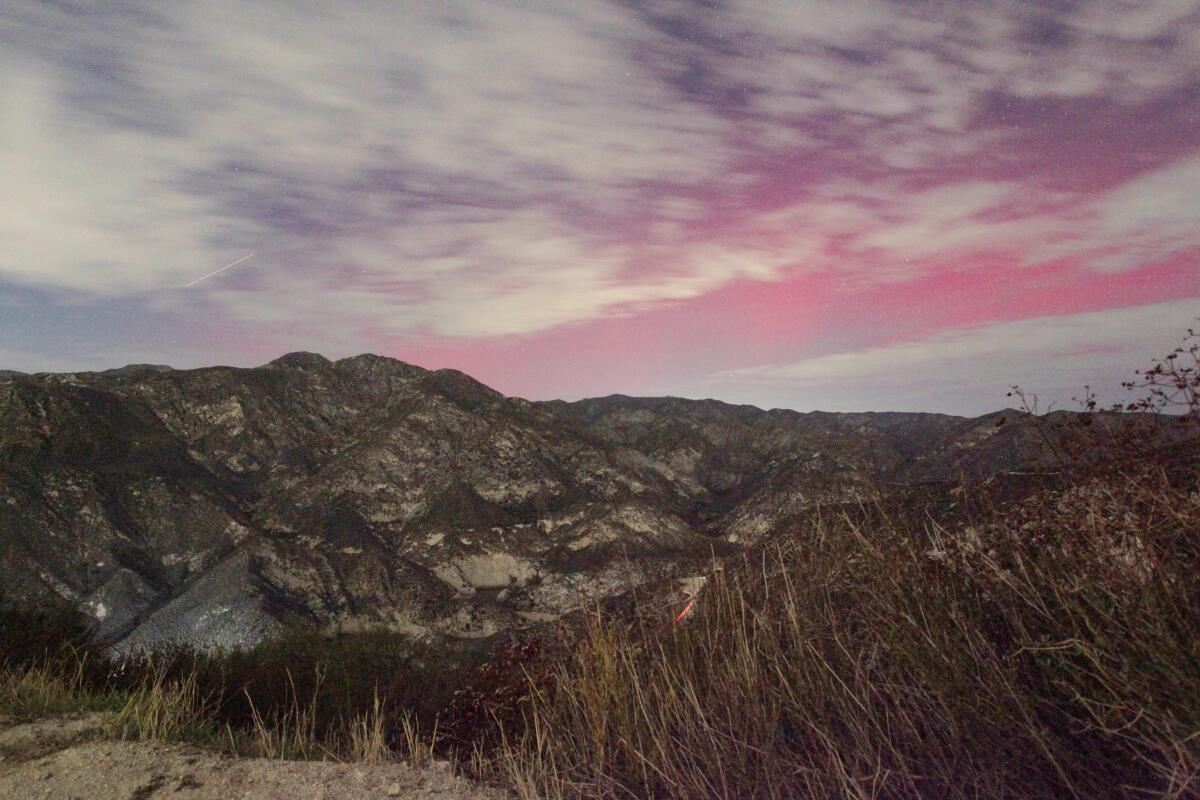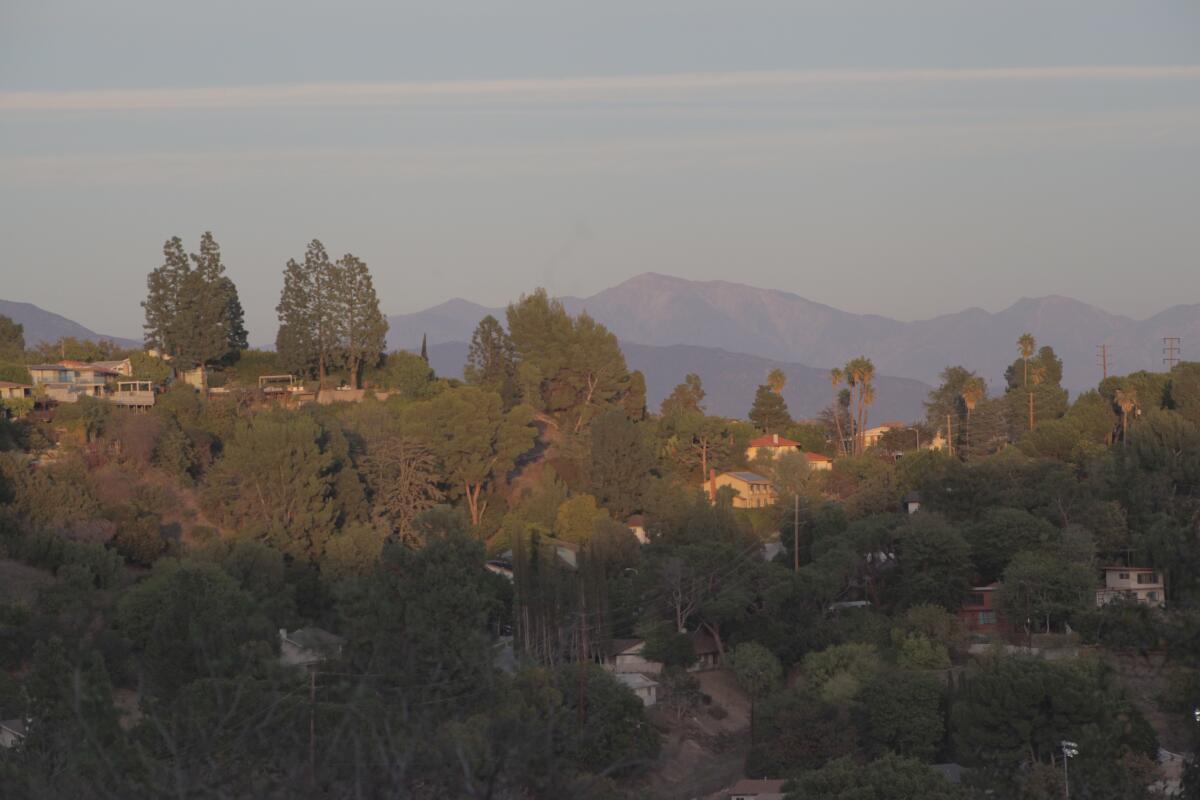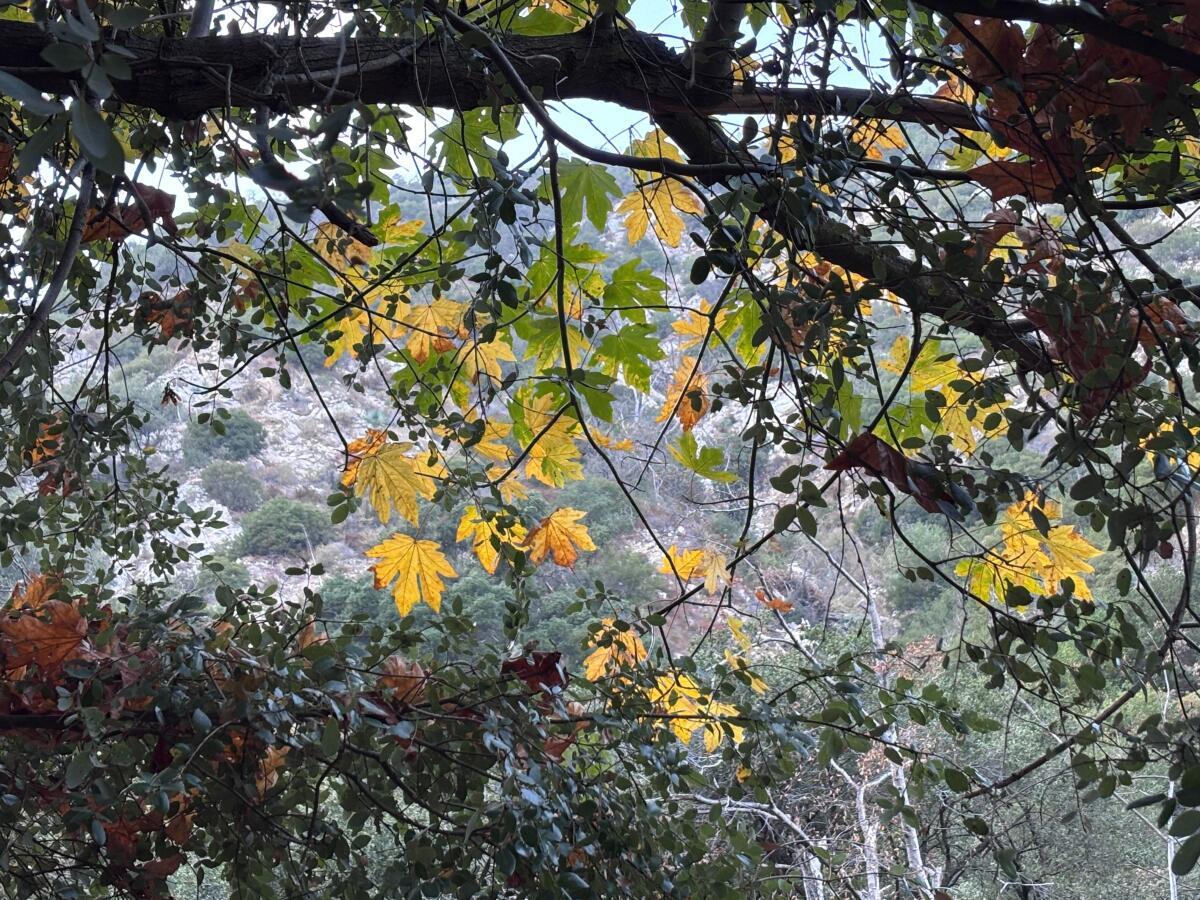How you can view the northern lights near Los Angeles
Last Tuesday, I asked my friend Mish if they’d like to skip our gym trip and instead drive into Angeles National Forest for a chance to view the northern lights.
We decided, for our health, to go to the gym. We arrived around 7:15 p.m., only to realize our gym was closing early because of Veterans Day. Divine intervention or dumb luck? Either way, we left, got our cameras and snacks and headed up Angeles Crest Highway.
We stepped out of the car about 8:45 p.m., and I started shouting a flurry of joyful expletives. The pink glow of the northern lights was visible to the naked eye, shining near Mt. Gleason.

The northern lights as seen from near Angeles Forest Highway on Veterans Day.
(Jaclyn Cosgrove / Los Angeles Times)
This was my second time viewing the northern lights from the San Gabriel Mountains. Last May, my buddies and I were out celebrating a friend’s sobriety anniversary when my pal Machiko texted me that — somehow! — the northern lights were visible in dark places around L.A. We quickly left Chinatown and headed onto Angeles Crest Highway.
At first, around 10:50 p.m., we could only see a faint pink glow and only by using our phone cameras. By 11:30 p.m., we’d found a darker place in the forest to park, and our cameras picked up quite the light show.
From there, I quickly became enamored, similar to eclipse chasers, with how I could see the northern lights whenever possible from Southern California.
Below you’ll find my tips on how to do just that. I want you, dear Wilder, to witness the sheer awe that comes with realizing there is so much about our universe we remain blissfully unaware of — until suddenly it’s a brilliant burning pink right before us.
If you’re reading this and getting major FOMO, have no fear! We will likely have another opportunity to see the aurora near L.A. soon enough.

The northern lights illuminate the sky of the North Bay as seen from China Camp Beach in San Rafael last May.
(Tayfun Coskun / Anadolu via Getty Images)
The sun plays a major role in why we have auroras, and it turns out we’re in a season when the sun might be sending more our way.
I spoke to Delores Knipp, research professor in the Smead Department of Aerospace Engineering Sciences at the University of Colorado Boulder, who explained to me that the sun has an 11-year “solar cycle.”
The sun reached its solar maximum period last year, and as NASA noted last year, “The solar cycle is a natural cycle the Sun goes through as it transitions between low and high magnetic activity. Roughly every 11 years, at the height of the solar cycle, the Sun’s magnetic poles flip — on Earth, that’d be like the North and South poles swapping places every decade — and the Sun transitions from being calm to an active and stormy state.”
Knipp said the sun now goes through a kind of relaxing period, during which the interactions of certain solar particles can create the most geomagnetic storms over a three- to four-year period. Good news? “We are about one year in,” Knipp said.
Why is that relevant to us? Because the aurora is “one manifestation of geomagnetic activity or geomagnetic storms,” according to the National Oceanic and Atmospheric Administration. And as I will explain below, the stronger the storm, the more likely it is that those of us in Southern California can see the aurora!
If you want to understand more about why auroras happen, consider checking out this presentation by Knipp, where she talks more about the science behind them — including historic auroras that really freaked out the public.
OK, let’s dive in. Here’s how I became an amateur aurora chaser, and you can too!

Mish, a friend of The Wild, sets up their camera near Angeles Forest Highway to capture the aurora visible from near L.A. on Veterans Day.
(Jaclyn Cosgrove / Los Angeles Times)
1. Sign up for alerts
You can sign up for free updates from the NOAA Space Weather Prediction Center to view its forecasts for upcoming geomagnetic storms and how intense they’re expected to be. (A simpler option is to view the predicted aurora viewline.)
2. Learn the data points
The first time a space weather alert lands in your inbox, you might have flashbacks to a high school science class where you sat puzzled, wondering if you could still graduate if you failed this class because science had always been your weakest subject. (Maybe that was just me.)
Regardless, in the NOAA Geomagnetic Forecast, you’ll notice a data table with the “Kp index forecast,” which is the planetary K-index and is used to measure the magnitude of geomagnetic storms. Generally to be visible near L.A., the K-index needs to be at 8 or 9.
As Knipp explained to me, “When Kp goes up to 6, 7 and beyond, what that means is the auroral zone tends to extend from its quiet regions around the northern part of Norway and northern part of Canada. It can extend all the way to mid-latitudes … and in our case, the edge of it [on Nov. 11] might have been in the northern tier of the United States. Those of us who are kind of standing off to the equator-ward side can look up into the sky and still see the disturbances that are moving along the [Earth’s magnetic] field lines. And those disturbances are created by particles that are crashing into our atmosphere as they move along the field lines.”
You might also notice in NOAA’s alert a G-scale, ranging from G1 to G5. This is the rating used to gauge a geomagnetic storm’s potential effects on satellites, spacecraft and the power grid, among other things. Meanwhile, the K-index is more of an intensity rating scale.
I start to pay attention when I see forecasts mentioning a possible G3 storm. I keep an eye out as the forecast grows more detailed about whether the storm is expected to intensify and become a G4 storm. And I watch the K-index to see whether an 8 is expected.
Last week, at around 5:30 p.m. and 8 p.m., the Space Weather Prediction Center emailed alerts noting that the agency expected a three-hour window from 7 p.m. to 10 p.m. PST where the K-index could reach 8. Lucky for my friend Mish and me, that’s when we arrived in the forest and found a place beyond the clouds to view the aurora.
3. Find a dark place with a northern view
You must drive beyond L.A.’s light-polluted skies to view the aurora.
There are many different websites dedicated to mapping light pollution. Last week, I found a north-facing turnout off Angeles Forest Highway that, per Dark Sky Map, was close to the “bright suburban sky” range on the Bortle scale, which stargazers and astrophotographers sometimes use to discern where to view celestial bodies.
Photographer Patrick Coyne posted to Instagram a video from Mormon Rock(s), about 12 miles east of Wrightwood in the San Bernardino National Forest, capturing a stunning pink aurora. Photographer Jason Anderson, whom I randomly met in the middle of the woods a few months ago, was among the luckiest, filming a deep red scene in Joshua Tree National Park.

Above the clouds and facing north, the lights from the aurora borealis were visible last May along Highway 2 in Angeles National Forest.
(Jaclyn Cosgrove / Los Angeles Times)
4. Bring a camera, tripod and patience
I have a mobile phone (iPhone 15 Plus) that allows me, when in night mode, to adjust the shutter speed to 10 seconds. This essentially means the camera will take in as much light as possible within that 10-second time frame. The main image for this edition of The Wild was taken with my personal iPhone.
Mish brought their camera and tripod — while I used my iPhone and Canon DSLR — to photograph the aurora. We spent about an hour observing the aurora, and it seemed to pulse in intensity. Twice, it appeared brighter to the naked eye before becoming visible only on our cameras. By 10 p.m., the aurora had disappeared.
We headed back to L.A. hyper and eager for the next time the aurora was visible, with a goal to set up shop in the desert or some other dark corner of Southern California. Staring at the night sky has a way of inspiring you to dream bigger.

3 things to do

A young cyclist works on a bicycle at the CicLAvia Melrose event last year.
(Kirk Tsonos)
1. Watch for “Stranger Things” on a ride through L.A.
From 9 a.m. to 3 p.m. Sunday, Netflix and CicLAvia will host “Stranger Things 5 One Last Ride,” a special 4-mile open streets event where fans can bike, skate or walk down a car-free stretch of Melrose Avenue in celebration of the show’s final season. The free event will feature Melrose reimagined as Hawkins, the fictional town where the show is based, with photo ops, animations, live entertainment and more. Learn more at ciclavia.org.
2. Witness the warblers of Wilmington
Latino Outdoors Los Angeles and Communities for a Better Environment will host a community bird walk from 10 a.m. to noon Saturday in Wilmington. Guests will tour local resilience centers and walk through Banning Park. Register and sign a waiver at eventbrite.com.
3. Hike and help others near Pasadena
Nobody Hikes in L.A. and Walking Pasadena with host their 10th Will Hike for Food hike at 8:30 a.m. Friday along the Gabrielino trail near Pasadena. Hikers are encouraged to bring nonperishable food items to donate to Friends in Deed’s food pantry in Pasadena. Money will also be accepted for the organization, which provides food, hosts a winter shelter and builds relationships with unhoused people to ease them into housing and other services. Learn more at walkingpasadena.com.

The must-read

A family poses in early October near the west entrance sign of Joshua Tree National Park during the 43-day government shutdown. The park remained open to visitors despite the shutdown.
(Allen J. Schaben / Los Angeles Times)
If you visited Yosemite or Death Valley national parks during the 43-day government shutdown, you may have experienced more order than you expected. Trash cans were cleared. Bathrooms were cleaned. That’s because, as Times staff writers Lila Seidman and Alex Wigglesworth report, employees who greet visitors and those who work in maintenance and sanitation, law enforcement and emergency functions were kept on during the shutdown, a marked difference from the 2018-19 shutdown. A Death Valley ranger, who spoke on condition of anonymity for fear of losing his job, said resource damage was rampant then at numerous parks because the guidance “was, like, shutter your doors, skeleton crew, leave the park open.” Continuing to fund visitor services kept up a facade that all was well, but the government’s choice there speaks to a long-simmering fight over our national parks: whether to prioritize the guest experience or conservation more. During the longest shutdown in U.S. history, almost 9,300 of the park service’s total 14,500-member staff, or roughly 64%, were furloughed, many of whom work on their park’s conservation, research and education teams. For example, a firefighter at Joshua Tree National Park said there were once 30 people on the team that protects endangered desert tortoises and Joshua trees, monitors air quality and restores areas after a fire. During the shutdown, none were working regularly. There was one bright spot though: Officials deemed the feeding and monitoring of the area’s pupfish, a chubby little guppy (and one of the world’s rarest fish), essential during the shutdown, a ranger said, because they’re “this star animal of the park.”
Happy adventuring,

P.S.
The Wild is dark next week for Thanksgiving and will return Dec. 4. If you’d like to take a hike, I’d recommend my Wild article from last Thanksgiving outlining treks that make me feel grateful to live here. Or especially if you’re estranged from your family and not going to attend a Thanksgiving meal, consider soothing your soul with a waterfall hike (as long as weather allows). It’ll likely be less crowded at trailheads considering those out celebrating the holiday. Regardless of what you do, may you experience something outside that fills you with goodness and wonder!
For more insider tips on Southern California’s beaches, trails and parks, check out past editions of The Wild. And to view this newsletter in your browser, click here.

























